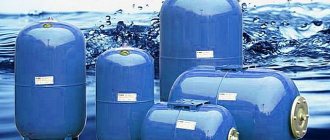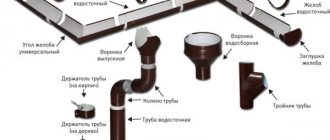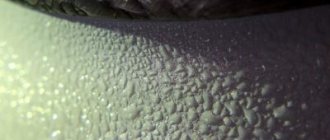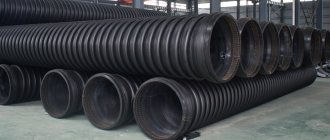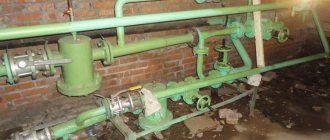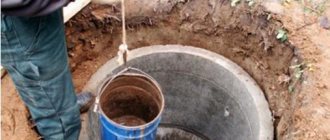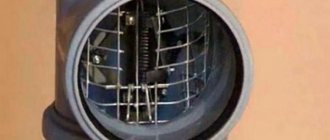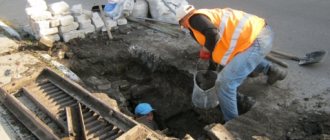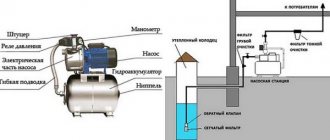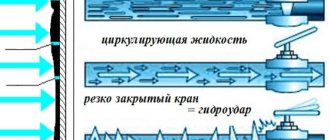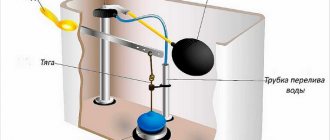Why does condensation appear?
What causes condensation to accumulate? First of all, this is:
- any source of moisture.
- significant temperature changes in the room (for example, when taking a shower, the room becomes warm and humid).
- poor ventilation (no windows or forced ventilation system in the room).
- features of the water supply distribution configuration (for example, hot and cold water supply works are too close).
- poor-quality thermal insulation of pipes.
Insulated pipeline Source kanaliza.ru
High humidity in the room can occur due to:
- Problematic communications and building features. A large amount of steam can appear during cooking, a clogged ventilation shaft, a flooded basement, evaporation that comes from drying laundry, etc.
- The presence of defects that may appear if construction rules are violated.
- Unfavorable natural phenomena (prolonged precipitation, humid climate of the region).
- Geographical features of the area. For example, there is a pond nearby or high air humidity is combined with rocky soil.
Condensation on pipes can appear either due to one of the listed reasons or due to a combination of them.
Fighting methods
Various approaches can be used to combat condensation. The main directions are the restoration of a normal microclimate with good ventilation in the toilet and thermal insulation of water supply lines.
Ventilation
In some cases, the formation of condensation is mainly due to insufficient ventilation in the toilet. To make sure of this, you can leave the door to the room unlocked all night and analyze the condition of the pipes in the morning. If the experiment has shown that a previously wet surface has become noticeably drier, then it is impossible to do without solving the ventilation issue.
There are several approaches to the solution:
You should check whether there is a gap of 10-20 mm under the toilet door.
It is necessary for air access to the toilet. Ways to eliminate the defect are to reinstall the door or install special ventilation valves in it that provide air flow.- Ensuring air flow from the street with more frequent ventilation. One option is to install a supply valve, which allows you to eliminate the problem without opening windows (it can be installed either in the wall or in the frame).
- Installation of exhaust ventilation, which will effectively remove moist air from the toilet. The device is usually installed halfway through a standard ventilation hole. The device can be turned on only when necessary, for example, after wet cleaning, and the rest of the time ventilation will be carried out in standard mode.
- The easiest and fastest way to remove excess moisture is to leave the toilet door ajar more often. This method can be used as a temporary method.
Thermal insulation
High-quality thermal insulation is a very effective method of eliminating condensation . This measure is aimed at eliminating the root cause of the appearance of water droplets on the pipe - the temperature difference between the water in the water supply and the air in the toilet.
Foam covers made of synthetic materials are used as a heat-insulating agent. It can be thermoflex, polyethylene, etc. They are produced in a wide range for different pipe diameters.
Before purchasing a thermal insulation cover, you need to measure the length and diameter of the pipe on which you plan to put it on.
You can install the covers yourself using the following algorithm:
- clean the surface of water supply lines from dust and dirt;
- if there is rust on the metal, it must be dealt with before installing the thermal insulation;
- taking into account all the bends of the pipe in the room, blanks are cut - separate for each straight section;
- on the covers there is a mark running along which each piece must be cut;
- after cutting the workpieces lengthwise, they are put on the pipes, bringing the edges of the longitudinal cuts together with your hands, without additional fixation;
- The bends (turns) of the pipes must be wrapped with electrical tape.
An alternative option is liquid thermal insulation. The composition should only be applied to prepared metal pipes - cleaned and primed. The method of application is chosen to be convenient: spraying, brushing. After the first layer has dried, apply the second. The product dries quite quickly - about an hour.
Air humidity
Poor ventilation is not always to blame for high humidity in the toilet. The reasons may be the following:
Presence of leaks. This could be, for example, water constantly running out of the tank.- When the toilet and bathroom are combined, drying wet laundry.
- Lack (or complete absence) of heating devices. The solution is to install an additional coil.
- Completely fill the coil with wet laundry and rags. As a result, even more moisture evaporates. To prevent this, the heated towel rail and hot water pipes should be as free as possible.
Consequences of condensation
Typically, in rooms where there are plumbing fixtures, air humidity is always higher than normal, so the appearance of water droplets on pipes is a common occurrence. If it appears periodically and is quickly eliminated, then there is no need to worry. But when pipes are constantly wet, this can lead to serious consequences:
- Mold formation. High humidity is an excellent environment for the development of fungus and other pathogenic microorganisms, which can lead to the formation of mold on surfaces, which is quite difficult to get rid of. In addition, mold and mildew on the walls can provoke the development of serious diseases.
- Flooding. Droplets of water that appear on pipes cannot disappear on their own. They flow down and, if there are cracks in the ceilings, they can penetrate to the neighbors below, causing flooding and damage to the floor covering.
- Damage to property. All things in the room can suffer from contact with water. Due to constant such interaction, plastic quickly loses its consumer properties, metal succumbs to rust, paint cracks, and ceramic tiles can fall off the wall.
Condensation on a metal-plastic pipe Source otvet.mail.ru
To avoid this, it is important to get rid of condensate on the pipes as quickly as possible.
Why is it formed?
Condensation is expressed in the appearance of small drops of water or complete wetness of the surface of pipes with cold water.
There are only two main causes of condensation:
- an increase in air humidity caused by the appearance of a source of active evaporation of water;
- the appearance of colder surfaces, changing the temperature ratio and causing moisture to settle.
The conditions for the appearance of condensation are a combination of these factors, enhanced by a large difference in temperatures.
For example, if a constantly wet surface is heated, it will stop attracting water vapor.
Conversely, if it is cooled sharply, the appearance of condensation will become inevitable. This phenomenon in itself is not a sign of any dangerous or undesirable processes. Attention! Condensation is dangerous due to its consequences - moisture begins to be absorbed into the wall materials, dampness and mold appear, steel elements are destroyed (fasteners, plumbing parts, when penetrating deep into the concrete, the fittings begin to rust).
In the bathroom
The appearance of condensation in the bathroom can have various reasons:
- Immediately after taking water procedures (especially after a hot shower) is normal. If moisture covers all surfaces - tiles, mirrors and other cold surfaces, but quickly evaporates (in normal conditions this process takes only a few minutes), there is nothing to worry about. This indicates that the room has normal ventilation, which actively removes water vapor.
- Leaking hot water or hot water pipeline .
They are much more dangerous, as they pose a risk of flooding of the apartment, and not only your own. A particularly dangerous sign is a leak in a hot water pipe. This is evidenced by the constant appearance of steam in one area or another of the room. Hot water evaporates more actively and creates increased humidity in the air. Cold water pipes, on the contrary, attract condensation. If there is a leak (not necessarily in the pipeline itself, a possible cause could be a valve that is not closed tightly), the pipe is constantly wet.
In the toilet
In the toilet, condensation appears on the cold water pipes and on the flush tank (less often on the toilet itself).
The main reason is incorrectly configured tank mechanics , which creates a constant leak.
It is noticeable if you look closely at the upper area of the water outlet in the toilet bowl.
Reference! Most often, the problem can be resolved by adjusting the tank. As soon as the constant flow stops, moisture settling will noticeably decrease or stop altogether.
On the riser
Condensation on the riser indicates the appearance of a constant water leak either in your apartment or in the apartments of neighbors on the upper floors. The water does not stagnate and does not heat up, so the temperature of the riser is noticeably lower than that of surrounding objects.
If the water vapor content in the air is increased, the surface of the pipe will immediately become wet. If the reason lies in your apartment, eliminating it will not be much of a problem. It is worse if a constant leak occurs on the upper floors of neighbors, since it is sometimes extremely difficult to determine the source and somehow influence the residents.
Determining the cause
Before you figure out how to remove condensation, you need to understand why it appeared in the first place. To do this you need:
- Check the ventilation by inspecting the grille and assessing its functioning. It's easy to do. It is enough to open the window slightly and bring the paper to the grille. If the leaf sticks to it, then ventilation has nothing to do with it. If the sheet falls, then the cause of moisture is a malfunction in the ventilation system. If an electric fan is installed in the room, turn it on and evaluate the condition of the pipe. Even if the condensation does not disappear in this case, the cause should be looked for elsewhere.
- Checking faucets and stopcocks. A problem in their operation can be noticed immediately, without the use of special equipment. If a leak is detected, it must be eliminated by replacing or adjusting the operation of the faulty parts of the system.
- Checking risers. Sometimes the appearance of condensation on pipes can be associated with a leak in neighbors.
- Checking the wiring. If the cold and hot water pipes are installed incorrectly and the distance between them is minimal, then condensation may appear on them. If water is supplied to both at the same time, a temperature difference will appear at the point of contact and droplets of moisture will appear on the surface. Typically, this situation is typical for private houses where laying of pipes was carried out by non-professionals. Correcting the situation in this case can be problematic, since it may require violating the integrity of the wall. But, usually it is enough to simply use insulation and reduce mutual heat transfer.
Using polyurethane foam on water pipes Source plitochkin.ru
If the ventilation and water supply system are working properly, the reason for the appearance of condensation may be due to temperature changes in the room. Droplets of moisture will always appear on the pipes if the difference in ambient and water temperatures is more than 17 degrees. Installing an additional room heating system will help eliminate this.
How to remove condensation, how to wrap pipes
Those who have encountered this phenomenon immediately have a question about how to wrap the pipe to prevent condensation. There are several ways to prevent water droplets from appearing on the surface of cold water supply pipes, one of which is thermal insulation. This option is considered the most effective, as it eliminates the cause of their appearance - temperature changes. The easiest and fastest way to solve the problem is to use an insulating tube, cutting it lengthwise for convenient placement. Foamed polyethylene, energyflex or thermoflex are used to make the tube.
There is another way to deal with condensation on pipe elements, but it is considered more complex. Using this option requires the following materials: epoxy putty, acetone, rust solvent, sanding paper, spatula, nylon thread and strips of fabric about 5 cm wide.
The process looks like this:
- The pipe is cleaned with sanding paper to improve surface adhesion.
- Degrease the sanded area with acetone.
- The surface is treated with a rust solvent and allowed to dry (about
Hood installation
Even at the stage of construction of residential buildings, specialists create a centralized ventilation system, which avoids disturbances in air exchange and, as a result, the appearance of moisture on the pipes. But sometimes it may not work effectively.
To avoid the formation of condensation, you need to install a forced ventilation system and turn it on regularly. This way, you will be able to get rid of steam or normalize air exchange.
Protecting a pipe from condensation using a thermally insulating coupling Source sense-life.com
Getting rid of moisture on metal pipes
The problem with metal systems is no less acute, because excess moisture threatens the formation of corrosion and complete wear of the pipes. Therefore, if condensation appears on cold water pipes, we will describe in detail what to do:
- The pipes are cleaned of rust, completely dried and coated with oil paint.
- A carbolate, a paste-like substance, is used to treat all kinds of cracks in the floor and walls. After complete hardening, it is also coated with oil paint.
- The entire water line is treated with a projector primer and then covered with enamel.
It should be remembered that the problem of condensation is often quite difficult to solve, so it is better to prevent its occurrence than to deal with the consequences later.
Using special devices
If it is determined that the reason for the formation of condensation on the pipe was precisely the temperature difference, you need to take care of insulating the riser. For this purpose special materials are used. They may differ not only in cost and appearance, but also in insulating properties.
The easiest way to insulate the drain is with foam material. It is easy to use and has minimal cost. Such linings are a soft pipe with a cut in it. This cover is put on the riser and glued together. To maximize the effect, it is important to choose the correct size of the insulating pipe. If its diameter is too large or small, then it will have no effect.
Heat-insulating paint, which is applied in several layers to the problem riser, will be more expensive, but more effective. When working with this material, it is necessary to properly ventilate the room.
Thermal insulation of pipes on the street Source sense-life.com
Both of these methods can be combined to obtain maximum results. Before you put on the cover, you need to make sure that the paint is thoroughly dry. You can also apply paint over the attached nozzle.
The most labor-intensive way to protect against condensation is to use a plastic pipe whose diameter exceeds the size of the riser. The space between the pipes is filled with polyurethane foam.
Chemical insulating material Source superiorcoatingsolutions.com
How to remove condensate from cold water pipes
To prevent the appearance of water droplets on a “cold” pipeline, several methods have been developed. But the most effective is the above-mentioned thermal insulation of water supply elements. After all, it eliminates the main cause of this phenomenon: sudden temperature changes. The easiest way to perform thermal insulation is to use an insulating tube, on which a longitudinal cut is made for ease of placement on the pipeline.
Good to know! This product is made from porous material - foamed polyethylene, energy flex, thermoflex, etc.
To combat condensate on pipes, a more complex, but, according to experts, more complete method is also used. To implement it, you will need epoxy putty, acetone, strong thread, spatula, rust converter, strips of fabric 5-6 centimeters wide and sanding paper. The sequence of actions looks like this:
- sand the water pipe. This will increase the adhesion strength;
- degrease the line element with a strip of cloth soaked in acetone;
- treat it with rust solvent;
- Allow the pipe surface to dry. Then apply a layer of thick epoxy putty on it;
- Promptly wrap the water pipe with cloth. Secure its edge with a strong thread;
- similarly form 2-3 more insulating layers of fabric;
- Apply a layer of epoxy putty again;
- wait until all layers are completely dry;
- sand the pipeline and coat it with paint.
When it turns out that water droplets appear due to leaking pipes, you can replace the failed section with a new elbow. And, if eliminating condensate on plastic cold water pipes in this way is quite simple, then for metal pipelines it is impossible to do without special equipment. You can contact the management company or a plumber for help. They will solve the problem as soon as possible.
To combat condensation, you can tightly wrap the pipes with fabric, and then apply a layer of paint.
Returning to the conversation about the appearance of condensation on plastic pipes, but in the absence of leaks, this phenomenon is prevented by using the following types of insulation:
- expanded polystyrene (foam plastic). This is the most universal insulation of polymer, for example, polypropylene “cold” pipes. It looks like a shell consisting of two halves. Thanks to the presence of a tongue-and-groove lock, the insulation is almost completely sealed. Have you noticed the appearance of condensation on polypropylene pipes? What to do? Frame the problem area with a “shell” and secure its halves with adhesive (preferably reinforced) tape;
- mineral wool, glass wool. Produced in special blocks according to pipe diameters or in rolls;
- polyurethane foam. This insulation demonstrates very effective insulating characteristics. It is capable of operating in the widest temperature range: -160 ≤ TºC ≤ +150. However, if we continue the conversation about polypropylene pipes, then the formation of a layer of this insulation on them is carried out in the factory. Its thickness is 30-50 millimeters.
Use of chemicals
If it is necessary to protect the pipeline from the formation of condensate drops on its surface, you can use special means: Asstratek, Stermizol, Corundum, etc. They are used as follows:
- The surface of the pipe is cleaned of dirt and rust. To do this, it is wiped or sanded.
- To make the mixture adhere better to the surface, it is coated with a primer.
- Using a brush or spray bottle, the substance is applied to the surface. It is advisable to apply at least 4-5 layers to be sure that droplets of moisture will no longer appear on the riser.
- To increase the service life of the pipeline, a fixative is applied on top of the insulating material.
Thermal insulation of pipes with mineral wool Source malivice.ru
What are the dangers of a “sweating” pipe?
The condensation that appears on the pipes is not just droplets of water. First of all, it is an aggressive environment for metal pipelines. In conditions of high humidity, the material corrodes and quickly fails.
In conditions of continuous humidification, a damp smell appears in the room. In addition, in places of high humidity, excellent conditions are created for the development of various bacteria, including mold and all kinds of fungi. Constant human contact with this kind of “neighbors” is extremely undesirable and can cause disruptions in the functioning of the body.
For metal pipes, constant humidity is fraught with rust.
If the appearance of condensation or its abundance is not detected in a timely manner, puddles may form on the floor. If they are not eliminated in time, then the time for repair work to replace the flooring in the bathroom can be delayed.
Using a steam trap
The main task of this device is to remove the moisture that appears. It is installed at the outlet of the heat exchanger (heater, water heater, etc.). This device removes moisture, separating it from steam. Steam traps can be thermostatic, float or combined. The most popular are the float types. Their action is based on the difference in density of steam and water droplets.
The advantage of using a float steam trap is:
- high reliability and efficiency;
- resistance to various types of load and temperature fluctuations;
- ability to work with light loads;
- no need to cool the formed condensate.
Float-thermostatic condensate trap Source evalve.ru
How to get rid
The problem can be resolved in different ways. We offer you 7 proven solutions.
Change the microclimate in the bathroom
If poor ventilation is to blame for the increase in humidity levels, then you need to take care of changing the microclimate.
What to do:
- Ventilate the room. If there is a gap between the floor and the doors, air will leak through it.
- If there is no gap, you need to check the ventilation duct. You can use a match/lighter for this. If the draft is weakened, it is necessary to clean the ventilation shaft.
- If cleaning the ventilation shaft does not produce results, you need to install an exhaust ventilation device. If the bathroom is combined, you should choose models with increased protection from moisture.
- Install an air dryer. This is a device that collects water molecules from the atmosphere. The larger the room, the larger the device should be.
- Install an air conditioner. The air conditioner will bring the temperature of the air around the toilet closer to the temperature of the water in the tank. Will reduce moisture content in the air.
If the bathroom is combined, it is useful to use an exhaust fan while taking a shower. It is turned on a few minutes before water procedures and left for 10-15 minutes after them.
The time you take a shower or bath should be reduced. Afterwards, wipe the glass curtain, bathtub, and walls. Excess moisture harms the microclimate. The water on the walls will evaporate into the surrounding atmosphere and condense on the toilet.
Raise the water temperature
The goal is to reduce the difference between the temperature of the water in the tank and the air in the room to reduce the formation of condensation on the tank.
What can be done:
- Insulate the pipeline. This will increase the temperature of the water in the pipes.
- Connect the hot pipeline to the tank. Instead of cold. Important: This may increase your utility bills.
- Install a boiler. Water heating system.
- Make a heat exchanger. For example, using a thermal riser.
You can install a half drain. This will dilute the cold water with warmer water.
Modernize the cistern
Modernizing the drain tank will also have a positive effect on the degree of condensation formation. What should be done:
- Insulate it. From the inside. This is done with polystyrene foam, polyethylene foam or isover. The main thing is to remember to turn off the water before starting work. And drain all the liquid from the tank. The slightest dirt is removed from the walls. Brush, sponge, cleaning agent. Remove rust from the inside and bottom.
- Place a second plastic tank inside the tank. The distance between both is 2-3 mm. Rubber gaskets are placed in the gap. Can be silicone.
- Install a new toilet. The new ones are equipped with condensation protection. They have a double tank - made of earthenware and plastic. Such toilets are not cheap, but they are reliable and last a long time. There are also quenching tanks. The cold water line is fed into a separate tank, which heats the water before it is sent.
- This job requires open access to the waterline and sufficient space for the reservoir, among other complications. You will almost certainly have to hire a professional to do the installation.
An example of insulating a toilet cistern with foamed polyethylene
The insulation layer should have a thickness of up to 10 mm. Otherwise, the volume of the tank will decrease.
Insulation inside the tank protects the porcelain surface from cold water. This allows the tank to be in the same temperature range as the rest of the room. Significantly reducing the degree of condensation.
Insulate the toilet
Insulating your toilet can reduce the overall humidity level in the room.
This will also improve the microclimate in the bathroom. You can insulate both the floor and the walls. And all together.
Make a double wall
Double wall toilet cistern
A double wall inside the tank is one of the most effective solutions.
A plastic reservoir can be placed inside the main tank. Plastic transmits heat better. Therefore, the water will warm up faster and the formation of condensation on the tank will be minimized. As stated above, you can immediately buy a new double-wall toilet. Then the temperature of the water in the tank will always be approximately the same as in the bathroom.
Fix the drain
If the tank leaks, the water in it does not have time to warm up to the required temperature. Same with other problems. Breakage of the shut-off valve and seal, wear of the bulb - all this contributes to the fact that the contents of the tank are regularly drained into the sewer. This also provokes the formation of condensation. Up to 1.5-3 liters per day.
Therefore it is necessary:
- repair or replace non-functioning components;
- remove limescale;
- replace the seal.
It is important that the drain does not touch the walls of the tank.
Do not drain the water completely
The more water is drained, the more is collected again. The incoming water is cold and does not have time to warm up completely. If you do not drain completely, there will be less new cold water.
To reduce drainage, two ways are suitable:
- Use a button with a minimum drain function. It is found on many modern toilets.
- Reduce drain pressure. For example, pressing a button very lightly.
- Adjust the drain valve so that pressing the button does not cause a complete flush.
There is an alternative option - visit the bathroom less. If you are a man, go to the sink, and the ladies will be patient.
Thus, condensation forms when warm, moist air hits a cold surface. A similar mechanism is observed in drinks with ice, when the walls of the glass fog up due to temperature differences. In the bathroom, a similar effect is eliminated by regulating the temperatures in the tank and in the surrounding atmosphere. The smaller the difference between them, the better.
Making your own thermal insulation
If you wish, you can insulate the riser yourself. What you will need for this:
- a piece of sandpaper to remove rust;
- phosphoric acid or any other rust converter;
- a piece of fabric (ideally cotton);
- strong thread, twine;
- putty.
Correct pipeline layout Source news.wjct.org
The insulation process is as follows:
- Prepare insulation. Any rag (an old sheet or towel) can become it. It is cut into strips no wider than 10 cm, which are rolled into a roll.
- Clean the surface of the water pipe, additionally degreasing it. Acetone or nail polish remover containing this substance is suitable for this purpose.
- The pipe is coated with a substance called rust converter, and after it dries with putty.
- After it dries, the fabric is wrapped around the pipe. This must be done so that each new turn made covers part of the previous one.
- The rags are soaked with putty.
- Using thread, the fabric is secured to the pipe.
- When the fabric is dry, it needs to be covered again with thermal insulation.
- Finally, a final layer of putty is applied.
- The surface is painted in the desired color.
How to eliminate condensation and insulate pipes
There are several ways to deal with the problem:
- Check the hood, remove debris and cobwebs, then buy a compact fan and install it instead of the ventilation grille. Manufacturers offer a wide range of similar devices, varying in price and power.
- Insulate the water supply system with special insulating tubes with a cut, which are available in construction supermarkets. They are made from energyflex, polyethylene foam, the ends are secured with permanent metallized tape. This method is the simplest and fastest, but the pipeline must be thoroughly dried before insulating.
- The following method will provide complete isolation. First, the pipe is sanded, then the surface is wiped with acetone, then with a rust converter. After drying the pipeline, it is covered with epoxy putty and quickly wrapped with strips of fabric in 2-3 layers, the edges of the fabric are fixed with a clamp and wire. Then epoxy putty is applied again, after drying, the surface is sanded and coated with paint.
Caustic soda for drain cleaning - pros and cons.
How to install a vent pipe in a private house?
How to disassemble a two-valve mixer?
Other condensation protection options
Experts also suggest the following ways to fix the problem:
- Application of isollate. This is a universal material that is suitable for pipe insulation. It is a thermal water-based paint that is applied to the problem riser. After complete drying, it turns into a polymer. The painting process is simple. First, the surface is cleaned and sanded. Afterwards it is degreased and painted with the composition. After it dries, a new layer is applied and so on 4-5 times. Finally, silicone varnish is applied, which makes the surface glossy.
Pipe repair by a plumber Source shvydkoservice.com
- Use of moisture absorbers. This is a household appliance that is designed to combat the problem of condensation on cold surfaces. It is a plastic container containing an absorbent substance.
- Installation of a split system. This option is the most expensive, so it is not suitable for everyone. Equipment with climate control function creates an optimal climate in the room. Such a system must be installed by specialists.
Installing a split system in a room with high humidity Source edilportale.com
How to get rid of condensation on pipes using improvised means
Sometimes it is not possible to arrange expensive measures to eliminate condensation - installing a hood, heated towel rail, insulation. For example, in a rented or temporary apartment. However, even in this case, water flowing through the pipes can significantly ruin the life of the users of the bathroom. To prevent drops from dripping onto the floor or furniture, you can use a simple method.
The pipe along the entire length of the “sweating” area is wrapped with gauze or a bandage (thin cotton cloth, rags) in two or three layers. The end of the winding is lowered as low as possible, directed into a container for collecting water.
Of course, this method is not suitable for constant use - the sounds of dripping water, the untidy appearance of the pipes, the constant action of liquid on the pipe material - all this leads to discomfort for users.
We get rid of the problem with the help of special devices
The simplest option is to purchase linings made of foamed thermal insulation material. They look like soft pipes with a cut along them. The insulation is put on the pipe like a cover and glued together.
It is very important not to make a mistake with the size. If you purchase an overlay with a larger diameter, there will be no effect, just like with a smaller size (you cannot glue this one).
A more expensive, but very effective method is to apply heat-insulating paint. To insulate a cold water riser, it is necessary to apply 4-6 layers of the substance, allowing each layer to dry completely.
When working with paint, it is important to ensure forced ventilation of the room. To do this, you can use a regular fan.
For greater effect, you can combine the two previous methods. Make sure the coating is completely dry before placing the insulation cover over the painted pipe. It is also possible to apply a layer of paint on top of the heat-insulating nozzle, but only after it is well fixed.
Another means of insulation is a larger plastic pipe placed over the main one. The resulting air space is filled with polyurethane foam.
Each of these methods is very effective, but if you did not count on the purchase of expensive coatings, you are better off using the old proven method - creating thermal insulation yourself.

